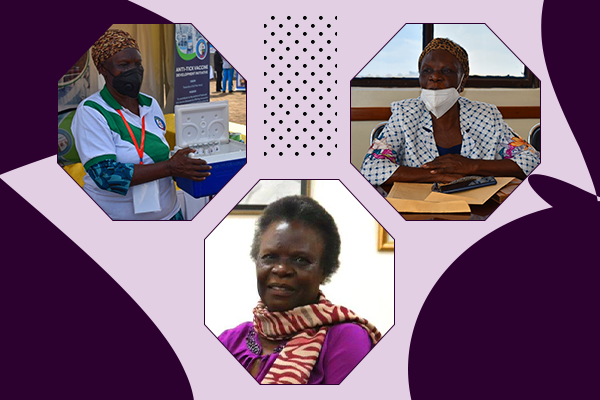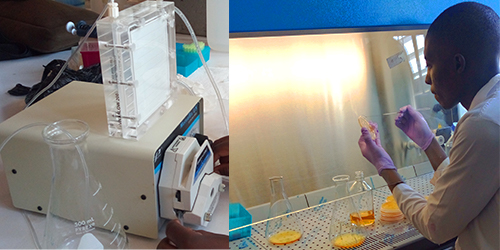2006-2009
- The journey of the research into a viable anti-tick vaccine began in 2006 when Dr. Margaret Saimo-Kahwa began research into an alternative immunological solution that could deliver an anti-tick vaccine to advance the prevention and control of ticks and tick-borne diseases in Uganda.
- Dr. Saimo-Kahwa identifies the protein (Ra86) from local ticks that could be the basis for the production of a recombinant local vaccine, noting that the protein occurs in two variant forms; either Ra92A or Ra85A in individual ticks in the field.
- With funding from the Dutch Research Council (NWO), the science division of the Netherlands Organization for Scientific Research (WOTRO), Dr. Saimo-Kahwa is sponsored to work on the tick gut proteins Ra86, identified from R. appendiculatus ticks found locally in East Africa and Uganda in a sandwich Ph.D. program between Makerere University College of Veterinary Medicine, Animal Resources and Biosecurity (CoVAB) and Wageningen University in the Netherlands.

In this work, the mid-gut proteins were expressed using the Baculovirus insect cell system to produce the proteins which were then used, to immunize rabbits.
2013-2015
- Dr. Saimo-Kahwa receives further funding from the Africa-Brazil Agricultural Innovation Marketplace to continue research and development of a yeast expression system using 'Pichia pastoris' via a technology transfer.
- The funding program connected scientists from Embrapa, “Brazil’s agency for agricultural research” with scientists from Africa and Latin America in research collaborations.
- The TicVac-U team’s sequences of the Ra86 gut protein variants (Ra92A and Ra85A) are synthesized and put into yeast “Pichia pastoris” and this technology of producing the anti-tick vaccine using yeast is transferred to CoVAB.
- The anti-tick vaccine development team builds the capacity to produce the proteins and formulate them into a candidate vaccine. Courtesy of Dr. Renato Andreotti, Bm86CG was donated to the TicVac-U scientific team.

2014-2017
- Under a CGS competitive grant from NARO, the Ra86 variant proteins are tested in cattle at a government farm in Ruhengyere for their effectiveness against natural tick challenges. Different combinations of Ra86 variant proteins plus Bm86CG protein (courtesy of Renato Andreotti, Embrapa) are tested to identify the best combination option, their stability, immunogenicity, and efficacy. During the study, there is a collaboration with the National Agricultural Research Laboratories Institute (NARLI Tororo) which provides the TicVac-U scientific team with ticks for attachment. A feasibility market survey of cattle keepers for the use of the anti-tick vaccine and a business plan for the production of the anti-tick vaccine are completed.
- The anti-tick vaccine receives strong support from H.E. the President of Uganda noting the crucial role it will play in keeping livestock healthy by preventing Tick Borne Diseases, hence boosting milk and meat production.

2016-2017
- During this period, anti-tick vaccine candidate proteins are multiplied to produce seed which is kept under -80oC deep freezer with funding from a competitive grant by the Uganda National Council for Science and Technology, under the National Science Technology and Innovation Program (NSTIP).
- The tick gut proteins (Ra92A, Ra85A & Bm86) seed cells are prepared in 'Pichia pastoris' yeast cells using an orbital shaker at CoVAB. The seed cells are kept under -80OC freezer ready to be used in the bioreactor. The Ra86 variant proteins plus Bm86CG were each evaluated for safety, immunogenicity, stability, and efficacy in mice and cattle. The best-performing colonies in each category were identified, quantified, and aliquoted in 1.5ml cryotubes.
- Among the outputs of the NSTIP funding was the establishment of a registered trade name and logo for the anti-tick vaccine – TicVac-U™), the development of a business plan, floating, and registration of a company in charge of the production of the anti-tick vaccine.
2017-2019
- The production and development of the anti-tick vaccine required a measure of upscaling the production to a commercial scale, the licensing of the product by the National Drug Authority (NDA), and setting up a current Good Manufacturing Practice (cGMP) facility with compliant production protocols. All these required investments and that’s why His Excellency (HE) in his wisdom (From 2017 to 2019) agrees to support the anti-tick vaccine development through the Presidential Initiative to accelerate the development of the vaccine.
2020-2021
- Stall experiments are carried out at CoVAB. Four more experiments are carried out on cattle with ticks being attached under controlled conditions. To facilitate the commercialization of this anti-tick vaccine, His Excellency recommends Alfasan Uganda Ltd to work with CoVAB under MOU to accelerate the development of the anti-tick vaccine.
- The signing of a Memorandum of Understanding between Makerere University, the TicVac-U™ team, and Alfasan Uganda Ltd to facilitate the production of batches of the candidate anti-tick vaccine for clinical trial phase 2.
- The President recommends a survey of 300 acres from Ngoma farmland be availed to Makerere to be used for the clinical trial of the anti-tick vaccine.
2022-2026
- Construction of the vaccine line at Alfasan (U) Ltd is complete, and the factory is issued with the suitability of premisses to produce veterinary drugs and vaccines.
- Production of recombinant Anti-tick Vaccine (TicVac-U) under cGMP conditions (2021-to date).
- Application for the license for the candidate anti-tick vaccine from the National Drug Authority to do clinical trials in the field using batches produced under cGMP compliant facility [Alfasan (U) Ltd].

Vaccine safety and efficacy
At the moment, the candidate anti-tick vaccine continues to undergo clinical trials across different cattle farms in Uganda as we continue to respond to the challenge of some of the most prevalent and economically important Tick-Borne Diseases affecting Uganda's cattle population such as East Coast Fever (ECF), Babesiosis, and Anaplasmosis. Commercial production of the TicVac-U anti-tick vaccine will commence this year, once vaccine is approved by the National Drug Authority.